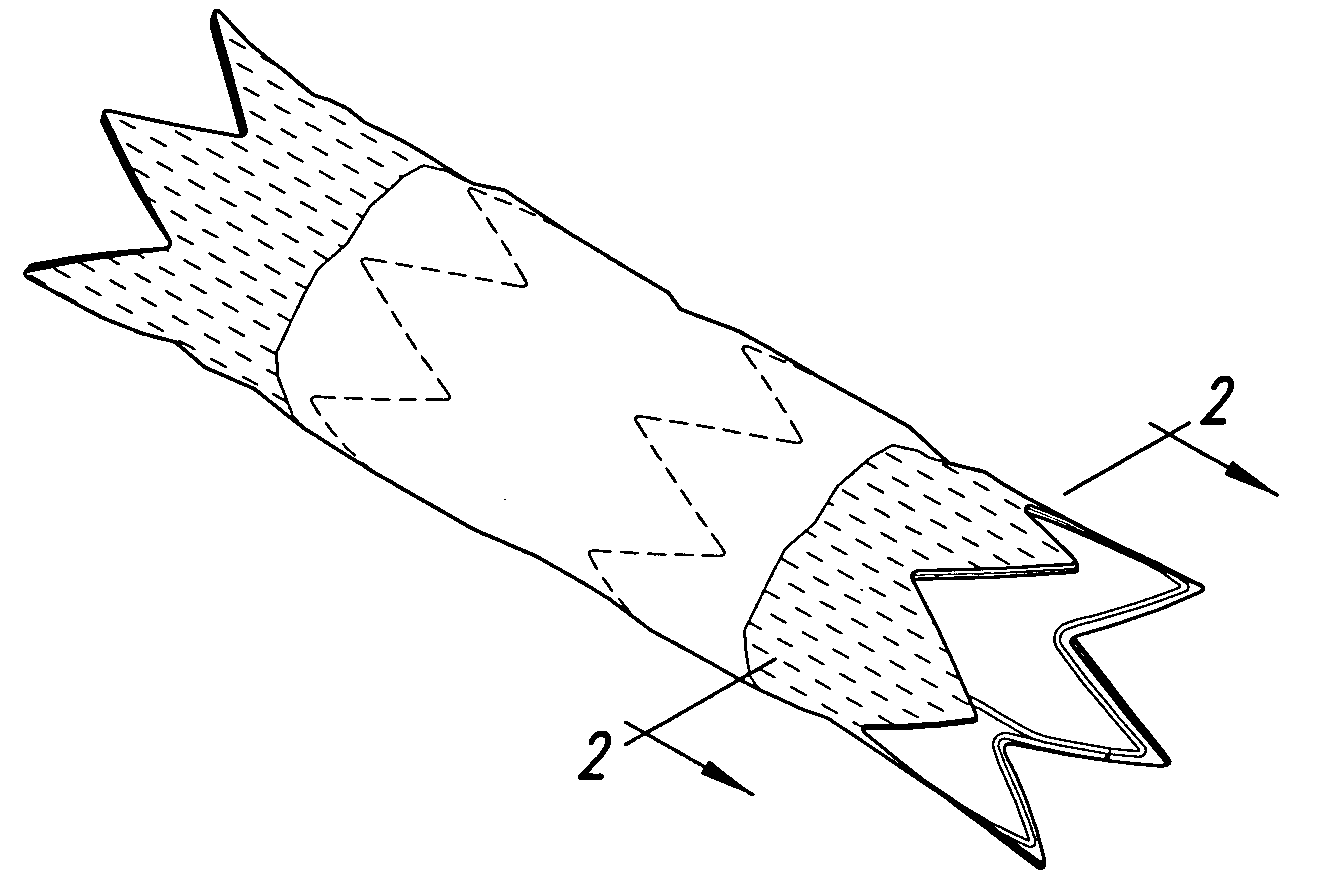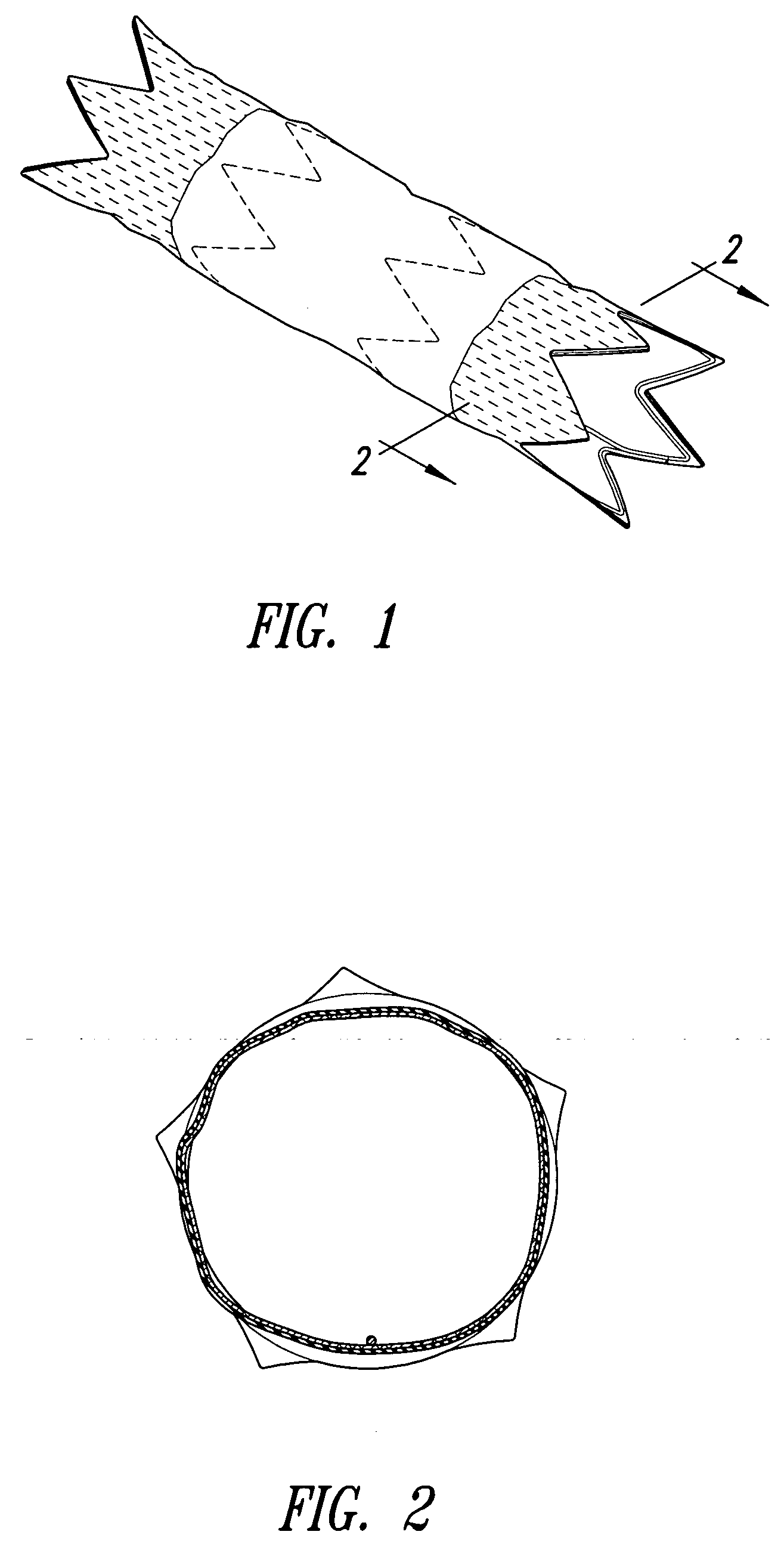Stent grafts with bioactive coatings
a technology of stent grafts and coatings, applied in the field of pharmaceutical compositions, can solve the problems of reducing pressure, stent grafts however have a number, and their tendency to burst, so as to reduce prevent the risk of rupture, and reduce the risk of aneurysm ruptur
- Summary
- Abstract
- Description
- Claims
- Application Information
AI Technical Summary
Benefits of technology
Problems solved by technology
Method used
Image
Examples
example 1
Coating of Intra-Anatomic Aortic Grafts with Fibronectin
[0088] The coating apparatus consisted of an overhead stirrer (Fisher Scientific) orientated horizontally. A conical stainless steel head was attached to the revolving chuck of the stirrer. One end of the intra-anatomic aortic graft was pulled up onto the conical head until held firmly. The other end was attached to a clip-swivel device that held the graft in a horizontal position, but allowed the graft to rotate along its axis. The stirrer was then set to rotate at 30 rpm so that the whole graft rotated along the horizontal axis at this speed. A 1% (w / w) fibronectin (Calbiochem, San Diego, Calif.) solution in sterile water was prepared. Two hundred microlitres of this solution was slowly pipetted as a 3 mm wide ring located 5 mm from the end of the graft fixed in the conical steel head over a period of 2 minutes as the graft rotated. The fibronectin was then dried under a stream of nitrogen as the graft continued to rotate. W...
example 2
Coating of Intra-Anatomic Aortic Grafts with Poly-L-Lisine
[0089] The coating apparatus consisted of a Fisher overhead stirrer orientated horizontally. A conical stainless steel head was attached to the revolving chuck of the stirrer. One end of the intra-anatomic aortic graft was pulled up onto the conical head until held firmly. The other end was attached to a clip-swivel device that held the graft in a horizontal position, but allowed the graft to rotate along its axis. The stirrer was set to rotate at 30 rpm so that the whole graft rotated along the horizontal axis at this speed. A 1% (w / w) poly-L-Lysine (Sigma, St. Louis, Mo.) solution in sterile water was prepared. Two hundred microliters of this solution was slowly pipetted as a 3 mm wide ring located 5 mm from the end of the graft fixed in the conical steel head over a period of 2 minutes as the graft rotated. The poly-L-Lysine was then dried under a stream of nitrogen as the graft continued to rotate. When dry, the graft wa...
example 3
Coating of Intra-Anatomic Aortic Grafts with N-Carboxybutyl Chitosan
[0090] The coating apparatus consists of a Fisher overhead stirrer orientated horizontally. A conical stainless steel head is attached to the revolving chuck of the stirrer. One end of the intra-anatomic aortic graft is pulled up onto the conical head until held firmly. The other end is attached to a clip-swivel device that holds the graft in a horizontal position, but allows the graft to rotate along its axis. The stirrer is set to rotate at 30 rpm so that the whole graft rotates along the horizontal axis at this speed. A 1% (w / w) n-carboxybutyl chitosan (Carbomer, Westborough, Mass.) solution in sterile water is prepared. Two hundred microlitres of this solution is slowly pipetted as a 3 mm wide ring located 5 mm from the end of the graft fixed in the conical steel head over a period of 2 minutes as the graft rotates. The n-carboxybutyl chitosan is dried under a stream of nitrogen as the graft continues to rotate...
PUM
| Property | Measurement | Unit |
|---|---|---|
| Adhesion strength | aaaaa | aaaaa |
| Adhesivity | aaaaa | aaaaa |
| Metallic bond | aaaaa | aaaaa |
Abstract
Description
Claims
Application Information
 Login to View More
Login to View More - R&D
- Intellectual Property
- Life Sciences
- Materials
- Tech Scout
- Unparalleled Data Quality
- Higher Quality Content
- 60% Fewer Hallucinations
Browse by: Latest US Patents, China's latest patents, Technical Efficacy Thesaurus, Application Domain, Technology Topic, Popular Technical Reports.
© 2025 PatSnap. All rights reserved.Legal|Privacy policy|Modern Slavery Act Transparency Statement|Sitemap|About US| Contact US: help@patsnap.com


